Pan Zhang
Inverse Knowledge Search over Verifiable Reasoning: Synthesizing a Scientific Encyclopedia from a Long Chains-of-Thought Knowledge Base
Oct 30, 2025Abstract:Most scientific materials compress reasoning, presenting conclusions while omitting the derivational chains that justify them. This compression hinders verification by lacking explicit, step-wise justifications and inhibits cross-domain links by collapsing the very pathways that establish the logical and causal connections between concepts. We introduce a scalable framework that decompresses scientific reasoning, constructing a verifiable Long Chain-of-Thought (LCoT) knowledge base and projecting it into an emergent encyclopedia, SciencePedia. Our pipeline operationalizes an endpoint-driven, reductionist strategy: a Socratic agent, guided by a curriculum of around 200 courses, generates approximately 3 million first-principles questions. To ensure high fidelity, multiple independent solver models generate LCoTs, which are then rigorously filtered by prompt sanitization and cross-model answer consensus, retaining only those with verifiable endpoints. This verified corpus powers the Brainstorm Search Engine, which performs inverse knowledge search -- retrieving diverse, first-principles derivations that culminate in a target concept. This engine, in turn, feeds the Plato synthesizer, which narrates these verified chains into coherent articles. The initial SciencePedia comprises approximately 200,000 fine-grained entries spanning mathematics, physics, chemistry, biology, engineering, and computation. In evaluations across six disciplines, Plato-synthesized articles (conditioned on retrieved LCoTs) exhibit substantially higher knowledge-point density and significantly lower factual error rates than an equally-prompted baseline without retrieval (as judged by an external LLM). Built on this verifiable LCoT knowledge base, this reasoning-centric approach enables trustworthy, cross-domain scientific synthesis at scale and establishes the foundation for an ever-expanding encyclopedia.
Quantum Flow Matching
Aug 17, 2025Abstract:Flow matching has rapidly become a dominant paradigm in classical generative modeling, offering an efficient way to interpolate between two complex distributions. We extend this idea to the quantum realm and introduce Quantum Flow Matching (QFM)-a fully quantum-circuit realization that offers efficient interpolation between two density matrices. QFM offers systematic preparation of density matrices and generation of samples for accurately estimating observables, and can be realized on a quantum computer without the need for costly circuit redesigns. We validate its versatility on a set of applications: (i) generating target states with prescribed magnetization and entanglement entropy, (ii) estimating nonequilibrium free-energy differences to test the quantum Jarzynski equality, and (iii) expediting the study on superdiffusion breakdown. These results position QFM as a unifying and promising framework for generative modeling across quantum systems.
ScaleCap: Inference-Time Scalable Image Captioning via Dual-Modality Debiasing
Jun 24, 2025Abstract:This paper presents ScaleCap, an inference-time scalable image captioning strategy that generates comprehensive and detailed image captions. The key challenges of high-quality image captioning lie in the inherent biases of LVLMs: multimodal bias resulting in imbalanced descriptive granularity, offering detailed accounts of some elements while merely skimming over others; linguistic bias leading to hallucinated descriptions of non-existent objects. To address these issues, we propose a scalable debiased captioning strategy, which continuously enriches and calibrates the caption with increased inference budget. Specifically, we propose two novel components: heuristic question answering and contrastive sentence rating. The former generates content-specific questions based on the image and answers them to progressively inject relevant information into the caption. The latter employs sentence-level offline contrastive decoding to effectively identify and eliminate hallucinations caused by linguistic biases. With increased inference cost, more heuristic questions are raised by ScaleCap to progressively capture additional visual details, generating captions that are more accurate, balanced, and informative. Extensive modality alignment experiments demonstrate the effectiveness of ScaleCap. Annotating 450K images with ScaleCap and using them for LVLM pretraining leads to consistent performance gains across 11 widely used benchmarks. Furthermore, ScaleCap showcases superb richness and fidelity of generated captions with two additional tasks: replacing images with captions in VQA task, and reconstructing images from captions to assess semantic coverage. Code is available at https://github.com/Cooperx521/ScaleCap.
Towards Storage-Efficient Visual Document Retrieval: An Empirical Study on Reducing Patch-Level Embeddings
Jun 05, 2025Abstract:Despite the strong performance of ColPali/ColQwen2 in Visualized Document Retrieval (VDR), it encodes each page into multiple patch-level embeddings and leads to excessive memory usage. This empirical study investigates methods to reduce patch embeddings per page at minimum performance degradation. We evaluate two token-reduction strategies: token pruning and token merging. Regarding token pruning, we surprisingly observe that a simple random strategy outperforms other sophisticated pruning methods, though still far from satisfactory. Further analysis reveals that pruning is inherently unsuitable for VDR as it requires removing certain page embeddings without query-specific information. Turning to token merging (more suitable for VDR), we search for the optimal combinations of merging strategy across three dimensions and develop Light-ColPali/ColQwen2. It maintains 98.2% of retrieval performance with only 11.8% of original memory usage, and preserves 94.6% effectiveness at 2.8% memory footprint. We expect our empirical findings and resulting Light-ColPali/ColQwen2 offer valuable insights and establish a competitive baseline for future research towards efficient VDR.
MM-IFEngine: Towards Multimodal Instruction Following
Apr 10, 2025Abstract:The Instruction Following (IF) ability measures how well Multi-modal Large Language Models (MLLMs) understand exactly what users are telling them and whether they are doing it right. Existing multimodal instruction following training data is scarce, the benchmarks are simple with atomic instructions, and the evaluation strategies are imprecise for tasks demanding exact output constraints. To address this, we present MM-IFEngine, an effective pipeline to generate high-quality image-instruction pairs. Our MM-IFEngine pipeline yields large-scale, diverse, and high-quality training data MM-IFInstruct-23k, which is suitable for Supervised Fine-Tuning (SFT) and extended as MM-IFDPO-23k for Direct Preference Optimization (DPO). We further introduce MM-IFEval, a challenging and diverse multi-modal instruction-following benchmark that includes (1) both compose-level constraints for output responses and perception-level constraints tied to the input images, and (2) a comprehensive evaluation pipeline incorporating both rule-based assessment and judge model. We conduct SFT and DPO experiments and demonstrate that fine-tuning MLLMs on MM-IFInstruct-23k and MM-IFDPO-23k achieves notable gains on various IF benchmarks, such as MM-IFEval (+10.2$\%$), MIA (+7.6$\%$), and IFEval (+12.3$\%$). The full data and evaluation code will be released on https://github.com/SYuan03/MM-IFEngine.
HiFlow: Training-free High-Resolution Image Generation with Flow-Aligned Guidance
Apr 08, 2025Abstract:Text-to-image (T2I) diffusion/flow models have drawn considerable attention recently due to their remarkable ability to deliver flexible visual creations. Still, high-resolution image synthesis presents formidable challenges due to the scarcity and complexity of high-resolution content. To this end, we present HiFlow, a training-free and model-agnostic framework to unlock the resolution potential of pre-trained flow models. Specifically, HiFlow establishes a virtual reference flow within the high-resolution space that effectively captures the characteristics of low-resolution flow information, offering guidance for high-resolution generation through three key aspects: initialization alignment for low-frequency consistency, direction alignment for structure preservation, and acceleration alignment for detail fidelity. By leveraging this flow-aligned guidance, HiFlow substantially elevates the quality of high-resolution image synthesis of T2I models and demonstrates versatility across their personalized variants. Extensive experiments validate HiFlow's superiority in achieving superior high-resolution image quality over current state-of-the-art methods.
SchemaAgent: A Multi-Agents Framework for Generating Relational Database Schema
Mar 31, 2025Abstract:The relational database design would output a schema based on user's requirements, which defines table structures and their interrelated relations. Translating requirements into accurate schema involves several non-trivial subtasks demanding both database expertise and domain-specific knowledge. This poses unique challenges for automated design of relational databases. Existing efforts are mostly based on customized rules or conventional deep learning models, often producing suboptimal schema. Recently, large language models (LLMs) have significantly advanced intelligent application development across various domains. In this paper, we propose SchemaAgent, a unified LLM-based multi-agent framework for the automated generation of high-quality database schema. SchemaAgent is the first to apply LLMs for schema generation, which emulates the workflow of manual schema design by assigning specialized roles to agents and enabling effective collaboration to refine their respective subtasks. Schema generation is a streamlined workflow, where directly applying the multi-agent framework may cause compounding impact of errors. To address this, we incorporate dedicated roles for reflection and inspection, alongside an innovative error detection and correction mechanism to identify and rectify issues across various phases. For evaluation, we present a benchmark named \textit{RSchema}, which contains more than 500 pairs of requirement description and schema. Experimental results on this benchmark demonstrate the superiority of our approach over mainstream LLMs for relational database schema generation.
SongGen: A Single Stage Auto-regressive Transformer for Text-to-Song Generation
Feb 18, 2025Abstract:Text-to-song generation, the task of creating vocals and accompaniment from textual inputs, poses significant challenges due to domain complexity and data scarcity. Existing approaches often employ multi-stage generation procedures, resulting in cumbersome training and inference pipelines. In this paper, we propose SongGen, a fully open-source, single-stage auto-regressive transformer designed for controllable song generation. The proposed model facilitates fine-grained control over diverse musical attributes, including lyrics and textual descriptions of instrumentation, genre, mood, and timbre, while also offering an optional three-second reference clip for voice cloning. Within a unified auto-regressive framework, SongGen supports two output modes: mixed mode, which generates a mixture of vocals and accompaniment directly, and dual-track mode, which synthesizes them separately for greater flexibility in downstream applications. We explore diverse token pattern strategies for each mode, leading to notable improvements and valuable insights. Furthermore, we design an automated data preprocessing pipeline with effective quality control. To foster community engagement and future research, we will release our model weights, training code, annotated data, and preprocessing pipeline. The generated samples are showcased on our project page at https://liuzh-19.github.io/SongGen/ , and the code will be available at https://github.com/LiuZH-19/SongGen .
Light-A-Video: Training-free Video Relighting via Progressive Light Fusion
Feb 12, 2025
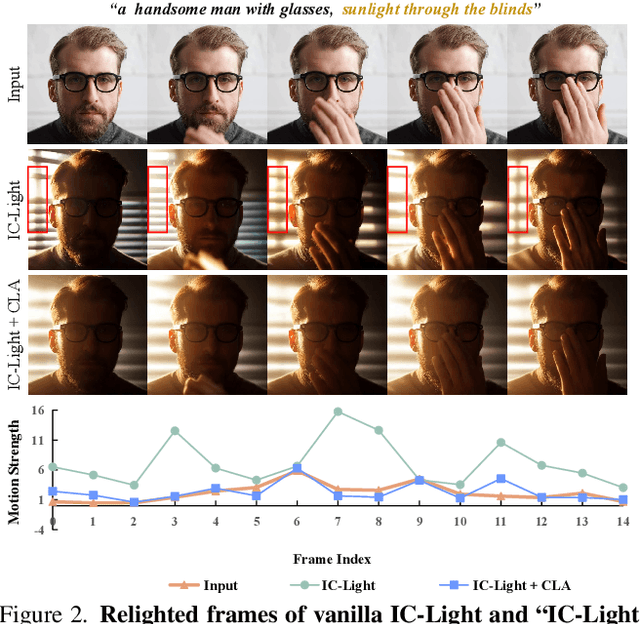
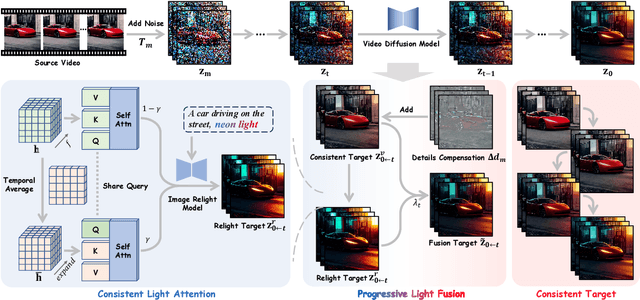
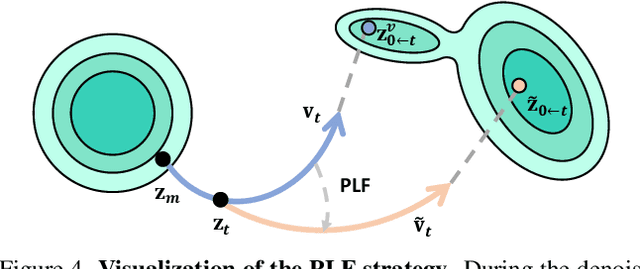
Abstract:Recent advancements in image relighting models, driven by large-scale datasets and pre-trained diffusion models, have enabled the imposition of consistent lighting. However, video relighting still lags, primarily due to the excessive training costs and the scarcity of diverse, high-quality video relighting datasets. A simple application of image relighting models on a frame-by-frame basis leads to several issues: lighting source inconsistency and relighted appearance inconsistency, resulting in flickers in the generated videos. In this work, we propose Light-A-Video, a training-free approach to achieve temporally smooth video relighting. Adapted from image relighting models, Light-A-Video introduces two key techniques to enhance lighting consistency. First, we design a Consistent Light Attention (CLA) module, which enhances cross-frame interactions within the self-attention layers to stabilize the generation of the background lighting source. Second, leveraging the physical principle of light transport independence, we apply linear blending between the source video's appearance and the relighted appearance, using a Progressive Light Fusion (PLF) strategy to ensure smooth temporal transitions in illumination. Experiments show that Light-A-Video improves the temporal consistency of relighted video while maintaining the image quality, ensuring coherent lighting transitions across frames. Project page: https://bujiazi.github.io/light-a-video.github.io/.
VideoRoPE: What Makes for Good Video Rotary Position Embedding?
Feb 07, 2025
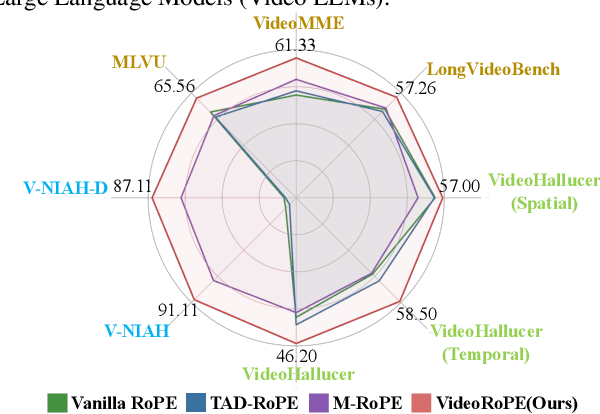
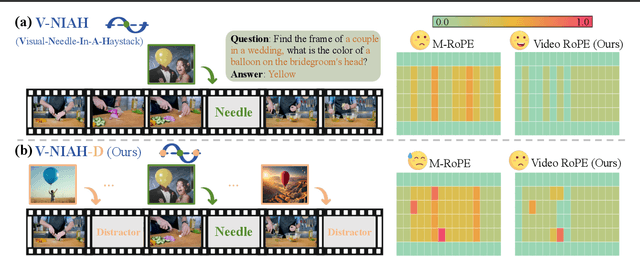
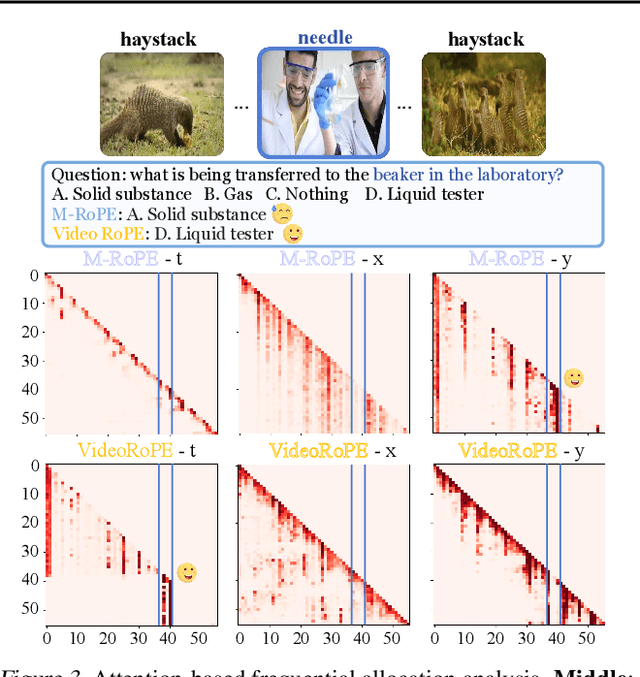
Abstract:While Rotary Position Embedding (RoPE) and its variants are widely adopted for their long-context capabilities, the extension of the 1D RoPE to video, with its complex spatio-temporal structure, remains an open challenge. This work first introduces a comprehensive analysis that identifies four key characteristics essential for the effective adaptation of RoPE to video, which have not been fully considered in prior work. As part of our analysis, we introduce a challenging V-NIAH-D (Visual Needle-In-A-Haystack with Distractors) task, which adds periodic distractors into V-NIAH. The V-NIAH-D task demonstrates that previous RoPE variants, lacking appropriate temporal dimension allocation, are easily misled by distractors. Based on our analysis, we introduce \textbf{VideoRoPE}, with a \textit{3D structure} designed to preserve spatio-temporal relationships. VideoRoPE features \textit{low-frequency temporal allocation} to mitigate periodic oscillations, a \textit{diagonal layout} to maintain spatial symmetry, and \textit{adjustable temporal spacing} to decouple temporal and spatial indexing. VideoRoPE consistently surpasses previous RoPE variants, across diverse downstream tasks such as long video retrieval, video understanding, and video hallucination. Our code will be available at \href{https://github.com/Wiselnn570/VideoRoPE}{https://github.com/Wiselnn570/VideoRoPE}.
 Add to Chrome
Add to Chrome Add to Firefox
Add to Firefox Add to Edge
Add to Edge